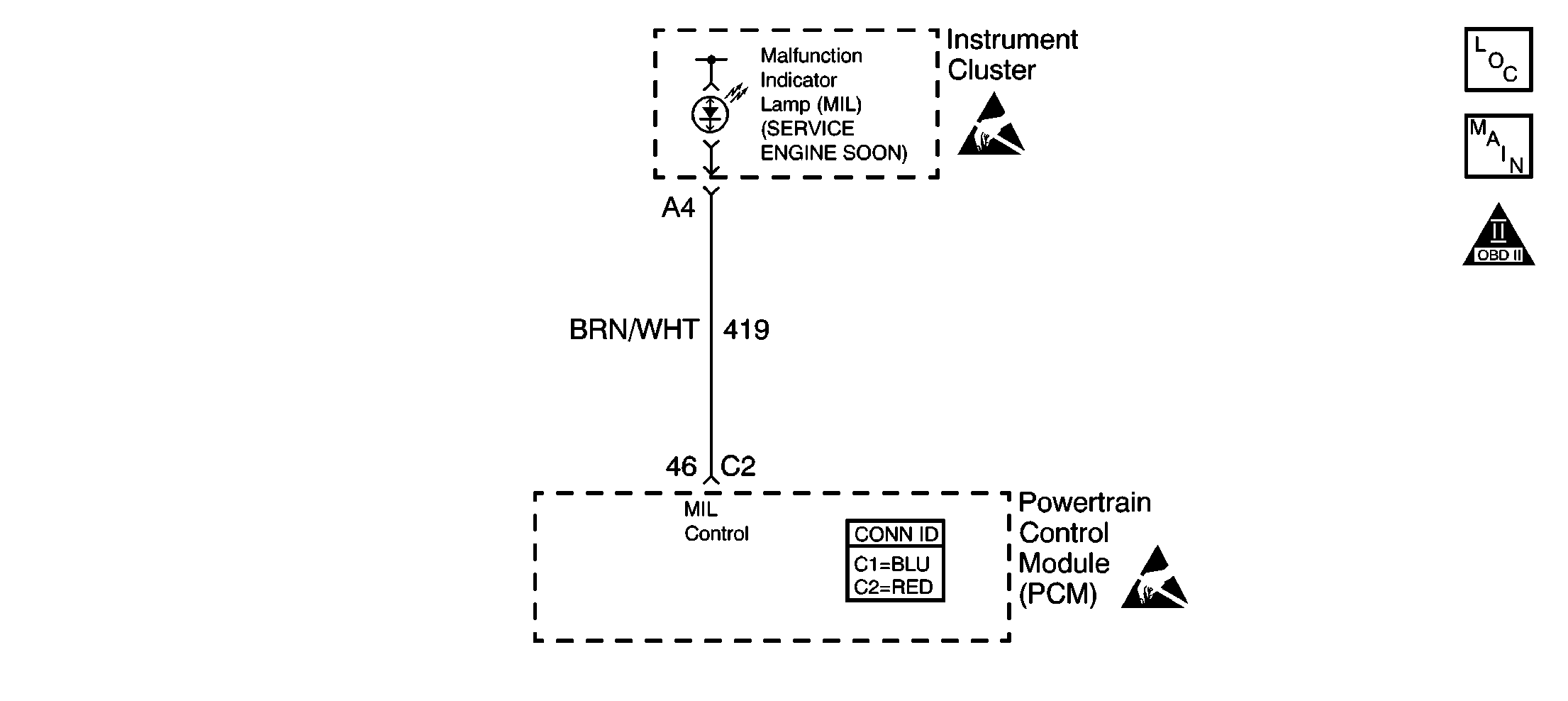
Circuit Description
A voltage is supplied directly to the malfunction indicator lamp (MIL). The powertrain control module (PCM) controls the lamp by grounding the control circuit via an internal switch called a driver. The primary function of the driver is to supply the ground for the component being controlled. Each driver has a fault line which is monitored by the PCM. When the PCM is commanding a component ON, the voltage of the control circuit should be near 0 volts. When the PCM is commanding the control circuit to a component OFF, the voltage potential of the circuit should be near battery voltage. If the fault detection circuit senses a voltage other than what is expected, the fault line status will change causing the DTC to set.
Conditions for Running the DTC
| • | Engine speed is more than 400 RPM. |
| • | The ignition voltage is between 6.0 volts and 18.0 volts. |
Conditions for Setting the DTC
| • | The PCM detects that the commanded state of the driver and the actual state of the control circuit do not match. |
| • | The conditions are present for a minimum of 5 seconds. |
Action Taken When the DTC Sets
| • | The PCM stores DTC P0650 in memory on the second consecutive ignition cycle that the diagnostic runs and fails. |
| • | The MIL will not illuminate. |
| • | The PCM records the operating conditions at the time the diagnostic fails. The first time the diagnostic fails, the PCM stores this information in the Failure Records. If the diagnostic reports a failure on the second consecutive ignition cycle, the PCM records the operating conditions at the time of the failure. The PCM writes the conditions to the Freeze Frame and updates the Failure Records. |
Conditions for Clearing the DTC
| • | A History DTC will clear after 40 consecutive warm-up cycles, if no failures are reported by this or any other non-emission related diagnostic. |
| • | A last test failed, or current DTC, will clear when the diagnostic runs and does not fail. |
| • | Use a scan tool in order to clear the DTC. |
Diagnostic Aids
Important:
• Remove any debris from the PCM connector surfaces before servicing
the PCM. Inspect the PCM connector gaskets when diagnosing or replacing
the PCM. Ensure that the gaskets are installed correctly. The gaskets
prevent contaminate intrusion into the PCM. • For any test that requires probing the PCM or a component
harness connector, use the J 35616
connector test adapter kit. Using this kit prevents damage
to the harness and component terminals. Refer to
Using Connector Test Adapters
in Wiring Systems.
| • | The following may cause an intermittent: |
| - | Poor connections -- Refer to Intermittents and Poor Connections Diagnosis in Wiring Systems. |
| - | Corrosion |
| - | Mis-routed harness |
| - | Rubbed through wire insulation |
| - | Broken wire inside the insulation |
| • | If the ignition feed circuit is suspected of being open, inspect for lamps on the same circuit not illuminating. |
| • | For an intermittent condition, refer to Symptoms . |
Test Description
The numbers below refer to the step numbers on the diagnostic table.
-
Command both the ON and the OFF states. Repeat the commands as necessary.
-
If you do not find trouble in the control circuit or the connection at the PCM, the PCM may be faulty. However, this is an extremely unlikely failure.
Step | Action | Values | Yes | No | ||||||
|---|---|---|---|---|---|---|---|---|---|---|
1 | Did you perform the Powertrain On-Board Diagnostic (OBD) System Check? | -- | ||||||||
|
Important: If the instrument panel (IP) is completely inoperative, refer to A Diagnostic System Check - Instrument Cluster in Instrument Panel, Gauges and Console.
Does the indicator lamp turn ON and OFF with each command? | -- | Go to Diagnostic Aids | ||||||||
3 |
Is the indicator lamp OFF? | -- | ||||||||
4 | Probe the indicator lamp control circuit in the PCM harness connector with a fused jumper wire connected to ground. Refer to Using Fused Jumper Wires in Wiring Systems. Is the indicator lamp ON? | -- | ||||||||
5 | Repair the short to ground in the indicator lamp control circuit. Refer to Wiring Repairs in Wiring Systems. Is the action complete? | -- | -- | |||||||
6 |
Did you find and correct the condition? | -- | ||||||||
7 | Inspect for the following conditions:
Did you find and correct the condition? | -- | -- | |||||||
|
Important:: The replacement PCM must be programmed. Replace the PCM. Refer to Powertrain Control Module Replacement/Programming . Is the action complete? | -- | -- | ||||||||
9 |
Does the scan tool indicate that this test passed? | -- | ||||||||
10 | Select the Capture Info option and the Review Info option using the scan tool. Does the scan tool display any DTCs that you have not diagnosed? | -- | Go to the applicable DTC table | System OK |
